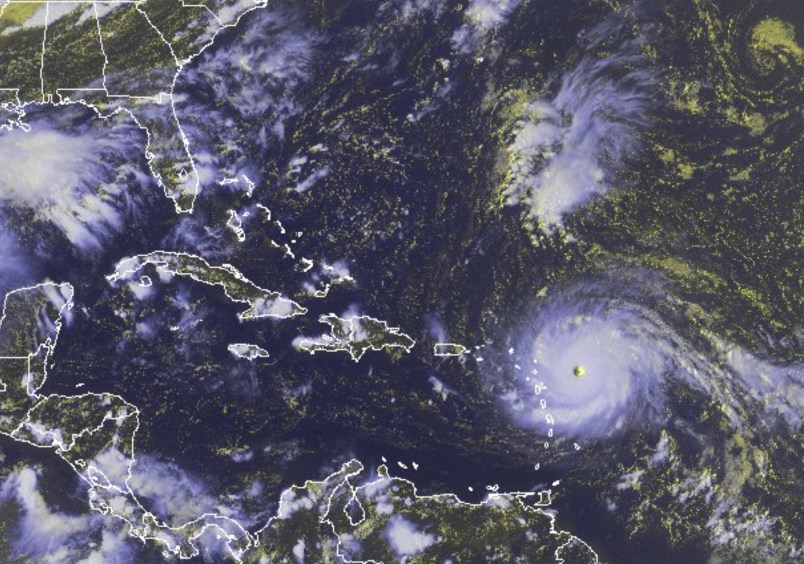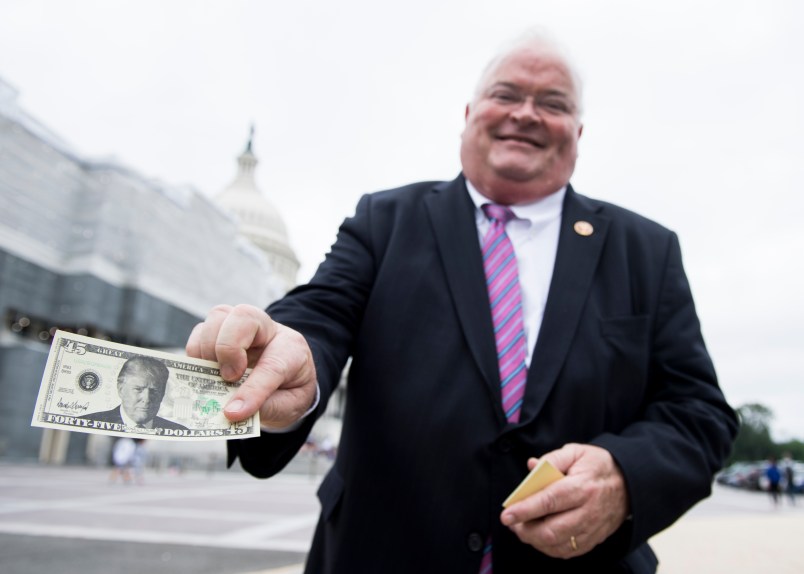SAN JUAN, Puerto Rico (AP) — Wielding the most powerful winds ever recorded for a storm in the Atlantic Ocean, Hurricane Irma bore down Tuesday on the Leeward Islands of the northeast Caribbean on a forecast path that could take it toward Florida over the weekend.
The storm, a dangerous Category 5, posed an immediate threat to the small islands of the northern Leewards, including Antigua and Barbuda, as well as the British and U.S. Virgin Islands and Puerto Rico.
“The Leeward Islands are going to get destroyed,” warned Colorado State University meteorology professor Phil Klotzbach, a noted hurricane expert. “I just pray that this thing wobbles and misses them. This is a serious storm.”
Irma had maximum sustained winds of 185 mph (295 kph) in late afternoon as it approached the Caribbean from the east, according to the U.S. National Hurricane Center in Miami.
Four other storms have had winds that strong in the overall Atlantic region but they were in the Caribbean Sea or the Gulf of Mexico, which are usually home to warmer waters that fuel cyclones. Hurricane Allen hit 190 mph in 1980, while 2005’s Wilma, 1988’s Gilbert and a 1935 great Florida Key storm all had 185 mph winds.
Irma is so strong because of the unusually warm waters for that part of the Atlantic.
Hurricane-force winds extended outward up to 60 miles (95 kilometers) from the center and tropical storm-force winds extended outward up to 175 miles (280 kilometers).
The center of Irma was about 130 miles (210 kilometers) east of Antigua and about 135 miles (220 kilometers) east-southeast of Barbuda, prompting an ominous warning from officials as the airport closed.
People in the two-island nation should seek protection from Irma’s “onslaught,” officials warned in a statement, closing with: “May God protect us all.”
Several small islands were directly in the path of the storm. In addition to Barbuda they included Anguilla, a small, low-lying British island territory of about 15,000 people.
Authorities there converted three churches and a school into shelters as they prepared for a big storm surge and the full brunt of the winds.
“People normally go to friends and family during a storm. We’ll see,” said Melissa Meade, director of the Disaster Management Department. “We’ll find out soon enough.”
The storm was moving west at 15 mph (24 kph), and the hurricane center said there was a growing possibility its effects could be felt in Florida later this week and over the weekend.
If it stays on the forecast track and reaches the Florida Straits, the water there is warm enough that the already “intense” storm could become much worse with wind speeds potentially reaching 225 mph, warned Kerry Emanuel, an MIT meteorology professor.
“People who are living there (the Florida Keys) or have property there are very scared, and they should be,” Emanuel said.
The storm’s eye was expected to pass about 50 miles (80 kilometers) from Puerto Rico late Wednesday.
“Puerto Rico has not seen a hurricane of this magnitude in almost 100 years,” Carlos Anselmi, a National Weather Service meteorologist in San Juan, told The Associated Press.
For the U.S. “this looks like at this point that it’s very hard to miss,” said University of Miami senior hurricane researcher Brian McNoldy. “You’d be hard pressed to find any model that doesn’t have some impact on Florida. Whether it’s the worst case or next-to-worst case, it doesn’t look good.”
For the Caribbean “even if the eyewall doesn’t pass directly over them, which unfortunately it’s going to do in the northern Leewards,” it will be big enough and close enough to cause nasty storm surge, heavy rain with mudslides, McNoldy said.
Authorities warned that the storm could dump up to 12 inches (31 centimeters) of rain, cause landslides and flash floods and generate waves of up to 23 feet (7 meters). Government officials began evacuations and urged people to finalize all preparations as store shelves emptied out on islands including Puerto Rico.
“The decisions that we make in the next couple of hours can make the difference between life and death,” Puerto Rico Gov. Ricardo Rossello said. “This is an extremely dangerous storm.”
Antigua and Barbuda Prime Minister Gaston Browne said he was confident Barbuda would weather the storm.
“I am satisfied that at a governmental level that we have done everything that is humanly possible to mitigate against the effects or the potential effects of this storm,” he said. “What is really required now is for Antiguans and Barbudans … to follow the warnings and to act appropriately so that we do not end up with any serious casualties.”
Puerto Ricans braced for blackouts after the director of the island’s power company told reporters that storm damage could leave some areas without electricity for about a week and other, unspecified areas for four to six months.
The utility’s infrastructure has deteriorated greatly during a decade-long recession, and Puerto Ricans experienced an island-wide outage last year.
Both Puerto Rico and the U.S. Virgin Islands expected 4 inches to 10 inches (10-25 centimeters) of rain and winds of 40-50 mph with gusts up to 75 mph.
“This is not an opportunity to go outside and try to have fun with a hurricane,” U.S. Virgin Islands Gov. Kenneth Mapp warned. “It’s not time to get on a surfboard.”
In Florida, residents also stocked up on drinking water and other supplies.
Gov. Rick Scott activated 100 members of the Florida National Guard to be deployed across the state, and 7,000 National Guard members were to report to duty Friday when the storm could be approaching the area. On Monday, Scott declared a state of emergency in all of Florida’s 67 counties.
Officials in the Florida Keys geared up to get tourists and residents out of Irma’s path, and the mayor of Miami-Dade county said people should be prepared to evacuate Miami Beach and most of the county’s coastal areas.
Mayor Carlos Gimenez said the voluntary evacuations could begin as soon as Wednesday evening. He activated the emergency operation center and urged residents to have three days’ worth of food and water.
A new tropical storm also formed in the Atlantic on Tuesday, to the east of Irma. The hurricane center said Tropical Storm Jose was about 1,505 miles (2,420 kilometers) east of the Lesser Antilles with maximum sustained winds of 40 mph (65 kph). It was moving west-northwest at 13 mph (20 kph) and was expected to become a hurricane by Friday.
___
Associated Press writers Anika Kentish in St. John’s, Antigua, Seth Borenstein in Washington and Ben Fox in Miami contributed to this report.










Nothing to do with climate change. Clearly, this is god’s will.
I can’t help but wonder - how often will the “once in a century” weather events have to occur within a span of a few years before the credulons get the message? Hurricanes Harvey and Irma are precisely what the climate scientists have been warning about.
They will never get the message, because their eyes and ears are permanently shut, though their tongues never stop flapping.
Exactly. They will never get the message. Their belief system is structured like a religion - it’s impervious to logic. They must be out-lived.
I’m 10 mi from beach on NC coast. Up to Cat2, I hunker down. Then afterwards, break out the shingles, crank up the generator and chain saw. Cat3? I’m off to the hills with all needed gear and memorabilia. Just aint worth the tribulation to hang around.
Their religion is money, and as long as they can make a buck off the fossil fuel economy, they will.
The only way to change their mind is to sue them for every god-d@mn penny they own and make it economically infeasible for them to continue. And we need to hit the banks funding them too.
http://www.ucsusa.org/publications/catalyst/su15-documenting-fossil-fuel-companies-climate-deception